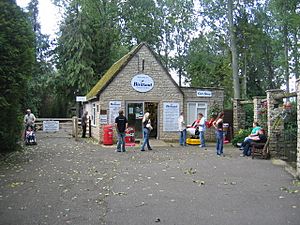Birdland Park and Gardens facts for kids

Entrance in 2006
|
|
| Date opened | 1989 (at current location) |
|---|---|
| Location | Bourton-on-the-Water, Gloucestershire, England |
| Land area | 7 acres (2.8 ha) |
| Coordinates | 51°52′49″N 1°45′15″W / 51.88028°N 1.75417°W |
Birdland Park and Gardens, often called Birdland, is a special wildlife park in Bourton-on-the-Water, England. It first opened in 1957. The park moved to its current home in 1989. Birdland started in the 5-acre (2.0 ha) grounds of a beautiful old manor house. It was created by Len Hill, who people sometimes called the "Penguin Millionaire."
Contents
Discover the Birds at Birdland
Birdland is home to about 500 birds. They live in more than 150 open aviaries. The park even has a part of the River Windrush flowing through it.
Unique Birds to Spot
Birdland is the only place in England, Wales, or Ireland where you can see king penguins. You can also find many other amazing birds here. Look for the colorful pink-backed pelicans. See the elegant Stanley or Blue cranes and white-naped cranes. Don't miss the large cassowary and the Marabou stork.
One very special bird is the golden conure. It's also known as the golden parakeet. Birdland is part of a worldwide program to help breed this bird. This helps protect them because they are a vulnerable species.
Special Habitats for Birds
The Desert House is a greenhouse with few plants. It creates a dry, warm home for birds that like desert-like places. Here, you might see desert finches.
Birdland also has the Marshmouth Nature Reserve. This 2.5 acres (1.0 ha) area is a natural home for local wildlife. You might even spot common kingfishers there.
The Story of Birdland
Birdland was opened in 1957 by Leonard W. Hill. He loved birds very much.
The Penguin Millionaire's Islands
In 1970, Len Hill bought some islands called the Jason Islands. These islands are in the Falkland Islands. He bought them for £5,500. Hill wanted to make them a private nature reserve for all the birds living there. He even traded birds from the islands with other wildlife places. This helped him get different birds for Birdland.
Unique Stamps and Banknotes
To help pay for his bird projects, Len Hill did something very unusual. In 1970, he had a postage stamp made for the Jason Islands. It showed him, the islands, and some gentoo penguins.
Later, in the 1970s, Hill even made his own bank notes for the Jason Islands! These notes came in different values, from 50 pence to £20. Each note had his picture, his signature, and a picture of a different penguin. For example, the £1 note showed a jackass penguin. These notes were only valid until December 31, 1979. The government of the Falkland Islands didn't stop him. They saw it as his own private idea.
New Owners for Birdland
After Len Hill passed away, his family sold Birdland and the Jason Islands. The Trigg family bought Birdland. Then, in 2012, Ian Cunningham bought it. The Jason Islands were given to the Wildlife Conservation Society. This made sure they would stay protected.
Exploring the Park Today
Birdland is a popular place to visit. It gets about 73,000 visitors every year. The park covers about 6 acres (2.4 ha) of woodland. It also has ponds and gardens. The River Windrush flows through the park, adding to its natural beauty.
Before Birdland moved to its current spot, this land was a trout farm. The park kept some of the old trout farm features. Before that, it was a poplar tree farm. Many of those old trees still stand today. They create a lovely green canopy over the park.
Birdland's Special Mascots
Birdland has a cool connection with the Central Flying School (CFS). The CFS is the oldest flying school in the world.
Patrick, Frederick, Cedric, and Duncan
In 1962, Len Hill gave the CFS its first live mascot. It was a pelican named "Patrick." Patrick was very famous and even had a BBC documentary made about him. He passed away in 1969.
After Patrick, other pelicans became mascots. "Frederick" became the mascot in 1971. He was trained at Birdland. Then came "Cedric" in 1987. The current mascot is "Duncan Le Gayt," who became mascot in 2001. Duncan lives a quieter life at Birdland now.

